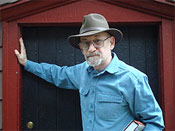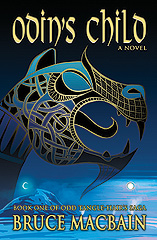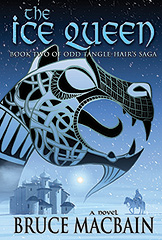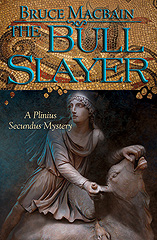In Odin’s Child (chapter
three), young Odd Tangle-Hair follows
his half-crazed father, Black Thorvald, up the slope of Mount Hekla, which
looms above their Iceland farm. Thorvald is seeking peace from the demons that
haunt him by communing with his dead ancestors, who live in the volcano’s fiery
depths.
We
had tramped for miles now [Odd tells us]and the ground was beginning to rise
and leave the mist behind. A hundred paces ahead of me I could see his back
bent over double as he toiled upward. I scrambled after him, my feet slipping
on the loose pumice stones and the fractured lava rocks with edges like knives.
I called his name but he went on as though he didn’t hear… Hours passed. Now I
had come as far as the snow-filled crevices that reached like skeleton fingers
down the blue-black mountainside. The going was very steep as I neared the top.
My palms and knees were bloody. An icy wind tore at my clothes and wailed in my
ears like the shrieking of ghosts…
All true, except for the icy wind. It
was actually warm on the day I made my assault on Mt. Hekla.
Two summers ago I and my wife
and sons visited Iceland—a country that I have been studying and fantasizing
about as I worked on Odd Tangle-Hair’s
Saga—and I resolved to confront this mountain of my imagination.
Mt. Hekla is about five
thousand feet high—taller than Vesuvius but not nearly as tall as Mauna Kea. It
is still very much a live volcano, and in the Middle Ages was believed to be a
gateway to Hell.
I’d made it about half way up,
after two exhausting hours of slipping on loose pumice stone, sliding into shallow
snow banks, and lagging farther and farther behind the group. Finally, my
guide, a very sweet young woman, whose name I no longer remember, gently
suggested that maybe I’d gone as far as I could. Reluctantly, I agreed. Anthony
and the others went on ahead, while she guided me back down the slope—gripping
my hand the whole way and chatting to me in excellent English.
The others would not be back
for hours. In the meantime, she took me in their little tour van over miles of
washboard roads to the site of a reconstructed Viking long house: something I
would have missed otherwise. So all ended well.
Anthony told me later that I
hadn’t really missed much. There was no pit of bubbling lava at the top, as far
as he could tell, and visibility was poor, so there wasn’t much to be seen from
the summit. Nevertheless, I am grateful for the experience, although the Hekla
I describe in my novel is still mostly the Hekla of my imagination.
And I now own a pair of mountaineering pants from
L. L. Bean made of wool about a quarter of an inch thick. I wore them again for
the first time this February, during our brutal Massachusetts winter.
So, no experience is ever
wasted.









